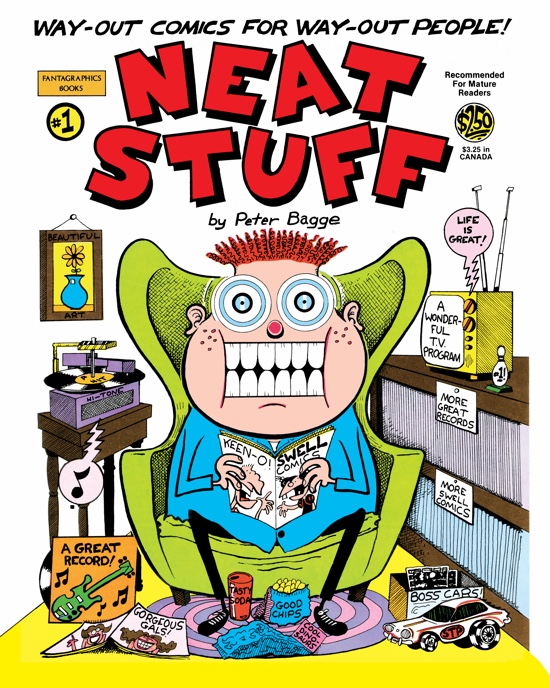Right now we all need cheering up, and what better way to do it than with comics. We’ve reviewed a huge stack for you this month, so let’s jump in.
Peter Bagge – Neat Stuff
(Fantagraphics)
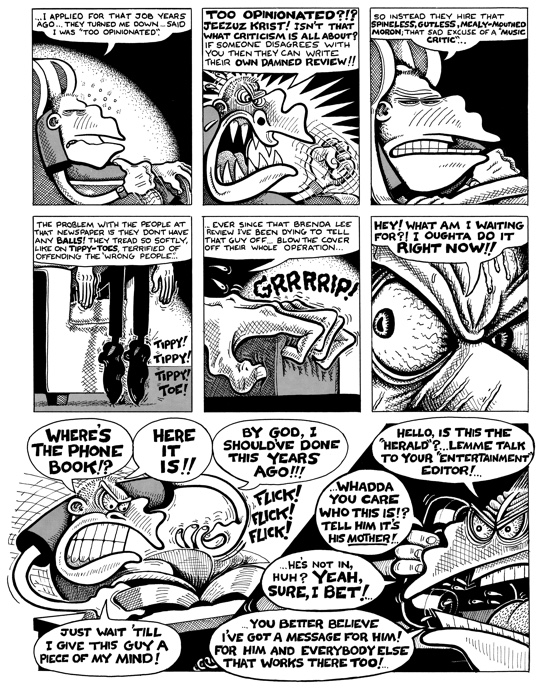
Fantagraphics certainly know how to put a decent reissue together. Following last year’s The Complete Eightball, this is an even larger boxed edition, containing two hardback volumes. It’s heavy, cast iron skillet heavy, and the comics look fantastic this size. As they were originally black and white with colour covers, here they are presented with all the covers at the front then the comics flow straight from one to another. In this sense it’s different from the Clowes box, with no attempt to exactly reproduce the individual issues.
Neat Stuff ran for 15 issues until Bagge replaced it with his long running Hate series. It features a varied cast of characters, some more successful than others. The Bradley family is the best known, and Bagge went on to make his alter-ego Buddy Bradley the subject of Hate. Studs Kirby is another example of the sort of thing Bagge excels at writing, a satirical and very funny right wing talk radio shock jock. The misanthropic couple Chet & Bunny Leeway are also pretty good. Girly Girl and Chuckie Boy are a bit one-note in contrast, but they aren’t given any of the longer stories so they don’t really outstay their welcome. As he makes clear in the end of issue #15, Bagge was bored of most of these creations, and felt they had run out of steam narratively.
It’s interesting to look at how the comic progressed. With issue #1, the art is instantly recognisable, with Bagge’s signature style already formed. The storytelling is less developed, though, with it taking second place to the pictures. The exception is the first Bradleys piece, and it’s easy to see why these characters stuck, even at this stage. By the second issue, the narratives are much improved, with a great Studs Kirby. It might be too convenient an interpretation to imagine that Bagge had the characters by #1 but that the stories didn’t arrive til #2, but the work supports this reading. From #2 onwards, the writing is mostly superb, matching the art. As the series goes on, some issues are entirely devoted to single characters – the second book of the box has several of these. Standouts include Hippy House with Buddy Bradley and The Rival with Studs Kirby, two of the best pieces here.
Bagge’s work has so much exaggerated, manic visual energy. The characters undergo full physical transformations depending on their mood, for example developing huge sharp teeth when angry, a frequent occurrence in his strips. Famously based on his own family, the Bradleys strips in particular convey the tense family dynamics that adolescence can bring through both the art and the writing. This is a great reissue in every respect. Peter Bagge is one of the most consistently entertaining American cartoonists, and this luxurious edition is an ideal way of catching up with what you’ve missed out on if you’ve not read Neat Stuff before. Pete Redrup
Seth & Luc Chamberland – Seth’s Dominion
(Drawn & Quarterly)
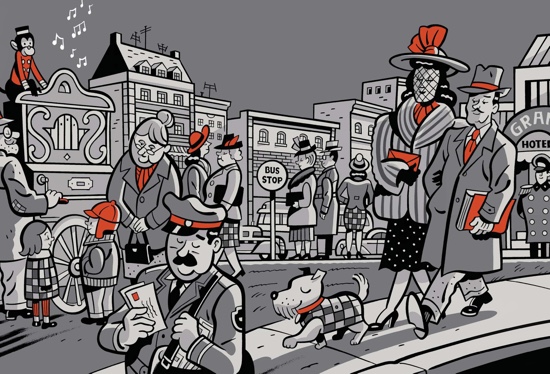
It’s hard to get excited about DVDs these days, but things might be different if more of them came packaged like this. Any Seth book is a sight to behold and an object to hold, and it could be argued that here we have two. Open it one way and we get a collection of photos from his childhood to the present day, showing family and friends, including some of the world’s most notable cartoonists. Open it the other, and there is a selection of his work, much of which would be extremely hard to come by without considerable quantities of both luck and money. Whichever way you start, get to the middle and you’ll find the DVD of Luc Chamberland’s documentary about Seth and his work. This has been extremely hard to track down outside of Canada – believe me I’ve tried – so it is indeed a treat to finally be able to buy it here, and as a bonus, so sumptuously packaged.
The film, at around 40 minutes, is an ideal length. It includes interviews in his studio, showing some of his personal diaries and how he creates them. It’s mesmerising to watch him inking and painting his work, to the point where I stopped listening and had to rewind. He expounds his philosophy of art, showing us his puppet theatre, the models of his fictional city of Dominion, and more. There are excerpts of short animations of his work, some voiced by actors but mostly narrated by Seth himself. Included are interviews with some of the peers we might expect, such as Chester Brown and Joe Matt. We learn about his childhood, his marriage, his day to day routine and his strong work ethic. This is absolutely fascinating for long term fans. Particularly striking is the breadth of his creations – as well as the comics, models and puppets there’s footage of his wife’s barbershop which he designed, and the book has photos of carnival floats with his characters. Whatever you think of Seth, he’s genuinely committed to his art.
There’s also a handful of extra features on the DVD – a couple of animated shorts directed by Chamberland and a talk at the D&Q bookstore, which are excerpted in the main feature, and a very short making of. The talk, like the documentary, reveals Seth’s dry, self-deprecating wit and comic timing. This is a beautiful object, a fascinating film supported by a wide range of interesting material. It gives us genuine insight into one of the finest cartoonists working today, but perhaps more importantly, it’s an absolute pleasure to spend some time in Seth’s world. Pete Redrup
Michael DeForge – On Topics 2
(Breakdown Press)
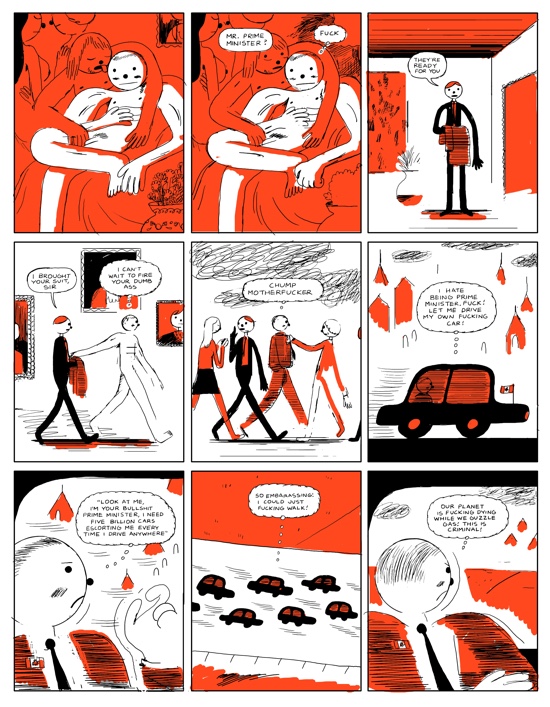
On Topics 2, a recent release from Breakdown Press, collects two pieces from DeForge. The Prime Minister Of Canada is first, a short story about, well, the Prime Minister of Canada. This particular leader is first depicted naked with three other people before being interrupted by an aide. We mostly get his internal monologue – “fuck”, “I can’t wait to fire your dumb ass”, “chump motherfucker” and so on – and it’s pretty funny. However, DeForge has always got more than one note to play, and it’s soon apparent that the PM is not entirely happy in his role. Soon enough he’s giving a speech, but after his “good morning”, thought bubbles begin to eclipse what he’s actually saying with his fervent belief that the whole political system is corrupt and in need of replacement. And so the simple gag – Prime Minister actually swears a lot – is replaced with something much more poignant, where he’s portrayed as a lonely individual, as confused and angry about politics as the rest of us. Near the end of the last page, his tie is printed in red for one frame, and it looks like a bullet hole to the chest dripping blood, before ending with the words “You’d have to be a fucking psychopath to want this job!". How timely.
Talking Sweat, the second piece, briefly reminded me of Chungking Express when Cop 223 runs so he can sweat instead of crying when he is sad. Here, crying is a particular form of sweating, the most emotional kind. In bright yellow we learn that humans have eight sweat bladders and that we die when they are depleted. The sweat bladder status of various other creatures is enumerated (oh to be a humpback whale, but pity the poor cat) as we learn a lot about the titular substance and even more about the proclivities of the narrator.
This is typically strong work from both DeForge and Breakdown, risograph printed in glorious colours on thick paper. What more do you need to know? Pete Redrup
Deborah Levy & Andrej Klimowski – Stardust Nation
(SelfMadeHero)
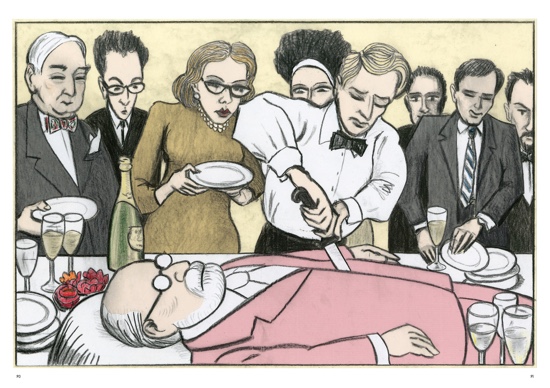
Sometimes it’s hard to argue with the pedigree of a book. Deborah Levy, Booker Prize-shortlisted author has adapted her short story Stardust Nation as a graphic novel, illustrated by Andrej Klimowski, Emeritus Professor at the Royal College of Art. Top that, everybody else.
Tom Banbury’s success in advertising comes from his ability to infiltrate the unconscious minds of consumers and convince them to buy what he is advertising. We only glimpse his work incidentally, however, as the book is more about his relationship with his colleague Nick, who is remembering Tom’s unhappy memories as his own. When Nick becomes unwell as a result, we meet his sister who informs Tom that her brother responds to the illness of family members. When they get ill, he gets ill she says, ‘so it’s lucky that none of us are mad, isn’t it?’
Of course, Tom does appear to be mad. We glimpse this through signifiers such as the strange transformations of appearance – when presenting a new marketing campaign he is feathered, with his arm sleeved in nails – no doubt linked to his deeply traumatic past. Tom and Nick are drawn to appear very similar, but Tom looks more predatory, with animal eyes. One of the central questions of this book is whose actions cause this bleeding from mind to mind? Is Nick invading Tom, or is Tom outsourcing his symptoms to Nick so he need not feel them?
This is a highly original graphic novel, spare and elegant in the writing, striking and sophisticated in the art. It’s a book that certainly lives up to its pedigree, and is another excellent SelfMadeHero release. Pete Redrup
John Riordan – Sound and Vision
(Dog ’n’ Bone)
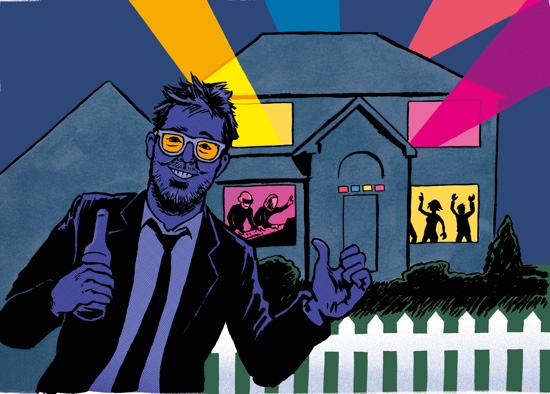
The latest book from John Riordan (whose excellent Hitsville UK series was reviewed here) is something of a departure in form and content, if not subject matter. This is a passionate and personal guide to 100 of his favourite musicians with illustrations and recommendations. As the introduction makes clear, he’s a big music fan, and his selections span five decades and a wide range of genres.
Obviously, having impeccable* taste myself, I was expecting that I would already know all the good stuff here, but as the book moves closer to the present day, I found myself motivated to address some gaps in my musical education.
Readers familiar with Hitsville UK or anyone who has seen the superb Twin Peaks prints he sells at festivals will already know his art is superb, bursting with energy and character. However, he’s also a talented writer, and his personal, conversational and often very funny prose is a good match for the subject matter. The world contains a seemingly infinite amount of music, and sincere and heartfelt guides to it are always welcome (that is one of the reasons why you’re reading tQ, no?), but they have to come across as genuine. Riordan has obvious passion for his selections, but is not afraid to be critical – he’s not very complimentary about Oasis, for example, which is almost as good as not including them at all.
This is a bright, entertaining book with excellent art – frankly, it’s worth the price of admission for the Bobby Gillespie drawing alone. It’s a great book to dip into, to be followed by some musical hunting, and dare I say it, could make an excellent gift for those seeking to subvert the anti-commercialism of Festivus at this time of year. Pete Redrup
*no, really, it is impeccable – read my reviews of numerous Julian Cope and Frank Zappa albums on this very site for confirmation.
Richie Pope – Fatherson (Frontier 13)
(Youth in Decline)
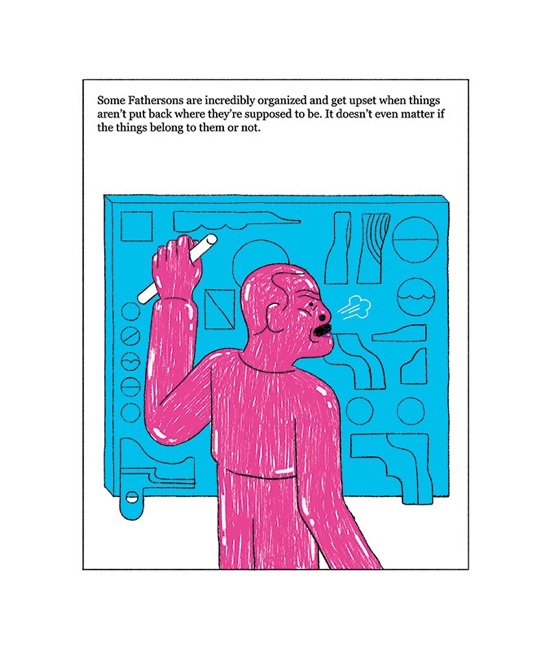
Youth in Decline’s third issue of Frontier this year is Fatherson by Richie Pope. In terms of layout, this is reminiscent of Michael DeForge’s Sensitive Property from 2015 – each page is a single, bordered panel with typed narration and no dialogue. Unlike that issue, however, this is not so much a story as a meditation.
The setup shows a medicine-like packet containing a small blue figure, not unlike a moustachioed jelly baby with longer arms. To activate the fatherson, it must be placed in a warm bath for an hour, but not disturbed during this soak, as turbulence “could result in unintended deformities or psychological flaws”. Once it awakens, you get to find out what sort of personality yours has. The rest of the comic contains descriptions of different archetypes of black fatherhood, sometimes with the following page describing the likely consequences of their actions. Behaviour is just described – the closest thing to an explanation we are given is “for no other reason than to pass the time”.
All the fathersons look the same, except for their shade, highlighting similarities and differences. Pope makes striking use of colours, using just four – blue, pink, purple and a Jake the Dog golden yellow. The repetition of shape, colour, panel size and deadpan narration combine to produce a unique, powerful work with a wry ending. Once again Youth in Decline demonstrate their cutting edge credentials in picking and presenting art in comics form. Pete Redrup
Mezzo & J.M. Dupont – Love In Vain: Robert Johnson, 1911-1938
(Faber & Faber)
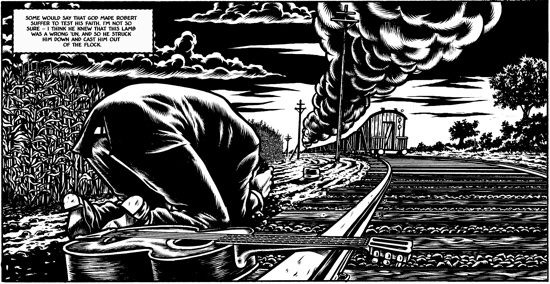
New out from Faber is Love In Vain: Robert Johnson, 1911-1938, a biography of the much mythologised blues musician. Drawn by Mezzo and written by J.M. Dupont, it provides an account of his life and ends with a collection of illustrated lyrics. It benefits from beautiful presentation – it’s a wide book with a cloth bound spine and thick, matt black paper covers. This is maintained throughout, as Mezzo’s artwork is fantastic, black and white with some stylistic similarities to Charles Burns. Characters, interiors, exteriors, rural and urban – all are strikingly drawn, often making particularly good use of the width of the book.
Much has already been written of his short life, one touched by tragedy. He appears to have caused at least as much unhappiness as the universe dealt him, especially if his misogynistic lyrics are indicative of his actions. The book does not judge him harshly for this, in part the result of a narrative device whereby the reader is left wondering from whose perspective the book is written, a revelation kept to the end which I shall not spoil.
Sadly, the writing does not match the standard of the art. There are frequent clumsy, distracting rhymes in the text, and sometimes the pacing between panels feels a little rushed. If you are a fan of Johnson and familiar with his story, the images alone will be more than enough. For the casual reader this is a little unbalanced, however, better to look at than to read. Pete Redrup
Grace Wilson – Saving Grace
(Jonathan Cape)
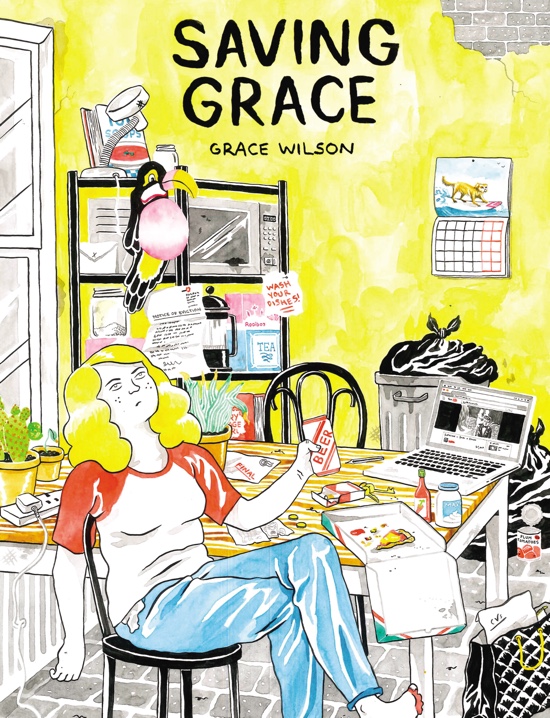
I was seduced by Grace Wilson’s visuals from the first juicy page; highly saturated watercolour textures playfully dancing within the tight yet fluid linework. Saving Grace is a beautiful book. It took me a bit longer to buy into the story. The characters are familiar and believable as is Grace’s situation, a little too familiar perhaps to another art school graduate living in London in the current climate.
The eponymous heroine’s struggle to find the motivation to create is never a point of narrative tension because the evidence that she eventually does find that motivation is sitting beautifully hard backed in the reader’s hands. The plot centres on how Grace can’t seem to catch a break for the majority of the book, but her situation never feels particularly dire. This of course is the danger of autobiographical work by people that weren’t lucky enough to live through a major conflict or develop a fascinating disease (I hope you can tell that is sarcasm). But during the course of the narrative a depth emerges that casts a wry critical eye on not only the sorry state of affairs that is the cost of living in London and the effect on its creative population, but also on the millennial attitude to this precarious situation – often one which consists mostly of drinking to forget it.
Although the blurb on the back of the book says that Grace must watch her friends make seemingly effortless progress, I found myself just as worried for all of the characters, none of whom seem safe from the trials of modern life. It feels like Wilson’s generation (read my generation, and probably your generation too) is stuck feeling unsure and sorry for themselves while the older people around her are full of certainty and thrilling stories, even the villainous ones. When Grace goes for a (comically disastrous) job interview at a school and begins to encounter the younger demographic, they too seem to have it way more together than she does. Her junior chaperone Hasan is definitely my favourite character. I don’t think the story here is what it’s sold as. But as I read on I found it increasingly funny and addictive. It’s nice to read a comic that feels so utterly current and I ended up rooting for Grace and her friends so the (not a surprise) happy ending was satisfying. And hey, if you’re struggling to find meaning or creative motivation in these semi troubled times, here’s an inspirational example from someone who managed to get it together. Jenny Robins
Wallis Eates – Fear of Mum-Death and the Shadow Men
(Self published)
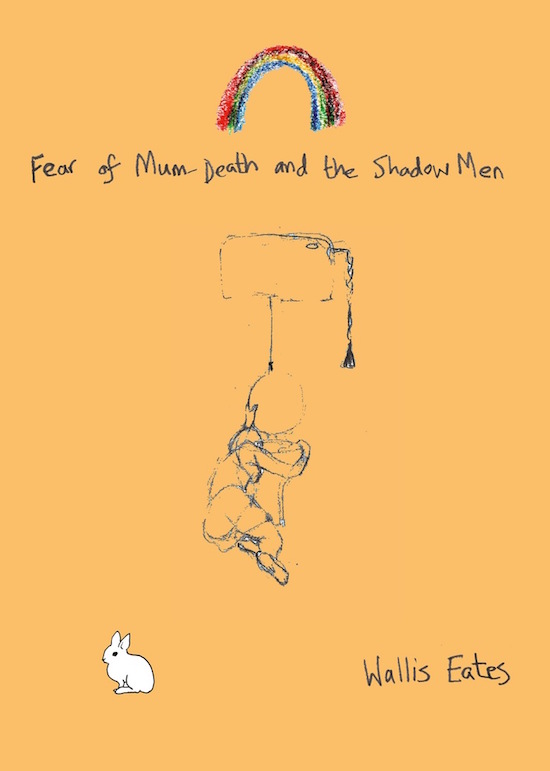
Somehow, Wallis Eates has a super human memory. She’s been obsessing over her childhood since she “became overwhelmed with memories” some time ago and has been writing and drawing comics about it ever since. The ongoing project Mumoirs is a collection of recollections of her life “growing up as an only child to a single mum in the 1980s as a working class family.” Of which this is a collection of some loosely thematically linked tales. I can only marvel at her ability to reproduce if not the exact moments and words of her childhood, at least a very believable approximation and definitely the emotion and that feeling of terrible helplessness most of us prefer not to recall.
The techniques used to both draw and structure these memories are as varied as their number, sometimes complex and intricate, sometimes very simple and at times they are reminiscent (I’m sure intentionally) of childrens’ own methods of writing, drawing and presenting. There is a sense that this is still a visual style in evolution, and we are seeing a work in progress section of what the final Mumoirs will be. If Eates is handing in her what I did at the weekend homework though, it is to herself as amendments were made as she put together the collection to publish with lined paper and red pen like a teacher marking work. If you like your autobiographical comics with a large helping of deadpan darkness and bittersweet grit, like Art Spiegelman or Alison Bechdel, you’ll love Wallis’ unabashedly British brutal honesty. The structure is not chronological but more like a rambling chain of thought that comes full circle as two particularly haunting images of a figure emerging from a densely hand shaded background bookend the collection. I once had an English teacher who told me that men write classical narrative which is straight and pointy like a penis, whereas women prefer circular narratives which resemble a breast. I think she (like Bechdel) had been reading a bit too much Freud, but in this case it works, and feels like a spiralling glimpse at the ascent through hell that builds a person. Jenny Robins
Fabien Grolleau & Jérémie Royer – Audubon: On the Wings of the World
(Nobrow)
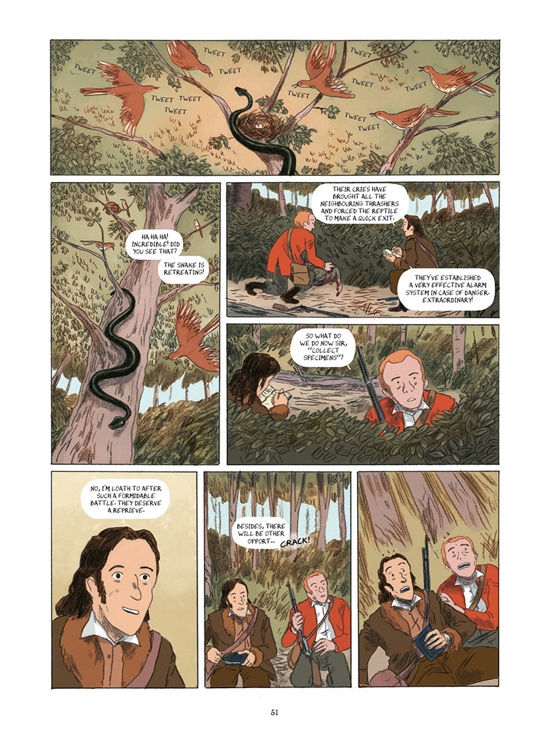
John James Audubon was an adventurer, naturalist and painter who lived from 1785-1851. His life’s work was the book Birds of America, which consisted of 435 aquatint plates of ornithological art. The comic book adaptation of his life by Fabien Grolleau and Jérémie Royer self-admittedly does not set out to convey Audubon in perfect historical detail, but like Audubon’s own writings, which the book is heavily based from, decides to embellish and romanticize his experiences in order to more accurately capture his personality, and the tall-tale-telling spirit of the times.
The book jumps back and forth between notable episodes in Audubon’s life, the first one being his discovery of an old sycamore in Kentucky with thousands of swallows nesting inside the hollow trunk. Audubon plucks over a hundred specimens from their nests to examine them further, which becomes the first act of Audubon’s complimentary attitude towards his love of birds, and his uncompassionate killing of them. In one of the most gruesome moments, Audubon horrifyingly skewers a recently shot blue jay with wires, and unemotionally twists the body into shape legitimizing his killing since blue jays are dirty thieves that gulp down the eggs of other birds. In an earlier episode, Audubon proudly brings a dead pair of nesting woodpeckers to his wife, which he exclaims to be extremely rare. Wouldn’t a naturalist want to keep rare birds alive so that they can reproduce and become less rare? Is Audubon so focused on birds that he has no idea about the bees?
Audubon’s barbaric behavior is at its worse when he takes part in a bison hunt, abandoning thousands of corpses across the prairie – unskinned and unclaimed for food. Audubon admits that the hunt might have been overzealous, but he does not condemn the slaughter, and moments later when he witnesses American Indians feeding on already deceased bison, he compares them to filthy beggars with no regard for the freshness of meat. I have chosen to perhaps unfairly focus on the negative qualities of Audubon’s character, but what makes this book such a fascinating read is instead of glorifying a person that was unarguably a passionate and expressive artist, it unflinchingly describes a man that was clearly a product of his time. Despite Audubon’s inability to reflect on his actions, he was able to inspire one of the largest conservationist societies, a legacy that I hope makes his less admirable deeds worth it. Matthew Laiosa
Moto Hagio – Otherworld Barbara
(Fantagraphics)
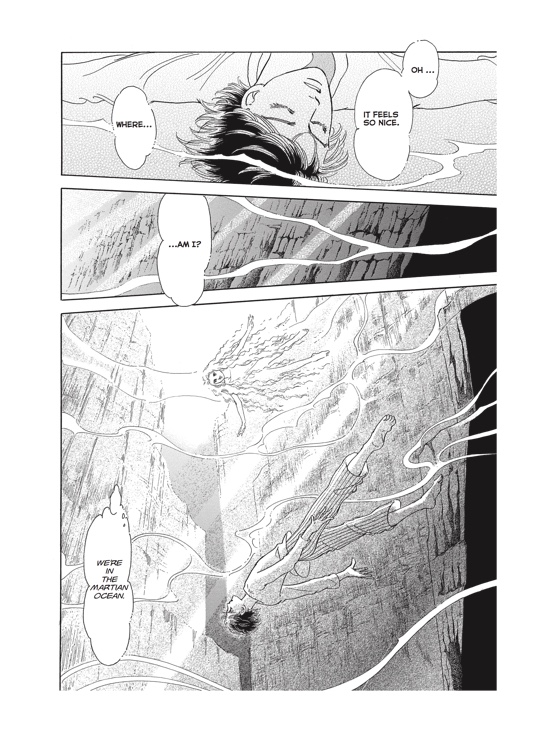
Seldom do comic books win top literary awards, although on occasion there are big winners including: the Pulitzer prize winning Maus, the Hugo awarded Watchmen, and perhaps this year’s National Book Award finalist, March: Book Three. Therefore when I saw that Otherworld Barbara by Moto Hagio won Japan’s equivalent of the Nebula award, I knew this would be a book to pick up.
Science fiction, fantasy, mystery, thriller, horror, romance, and drama seamlessly combine into a story that obviously has it all. The link between these many genres is the world of dreams, but what we come to discover is that dreams may not be as separate from our world as we believe. The main character is Tokio, a dream pilot. His job is to investigate the sleeping Aoba, a woman that has been living in a dream reality of her own creation for over a decade after possibly eating the hearts of her parents when she was nine years old. In this world children can fly like kites, pancakes are always on the menu, no one ever dies, and everyone lives on a mysterious hand-shaped island called Barbara. If this isn’t mystery enough, Tokio’s estranged son, Kiriya, also imagines the island of Barbara, and at times it appears momentarily in the real world.
How can two seemingly unlinked characters be dreaming the same world? This question and more unfortunately are unanswered since a second volume with the conclusion of the story won’t be released until 2017. However, there is plenty in this volume alone to whet your appetite including subplots involving a missing geneticist, a possible war with Mars, and a youth granting bodysuit. Despite the many plotlines, characters, and genres of Otherworld Barbara the story is simply told, and follows a clear linear narrative, so that even though every plot point ends in a cliffhanger, I am convinced that the narrative is heading towards a definitive end.
Otherworld Barbara is clearly a unique work that avoids simple comparison, but if Christopher Nolan were ever to direct a Haruki Murakami novel the result might be something in the realm of this extraordinary comic. Since Nolan has never made the attempt to adapt Japan’s master of surreal fiction we will have to satisfy ourselves with Moto Hagio, a master in her own realm of manga storytelling. Matthew Laiosa

